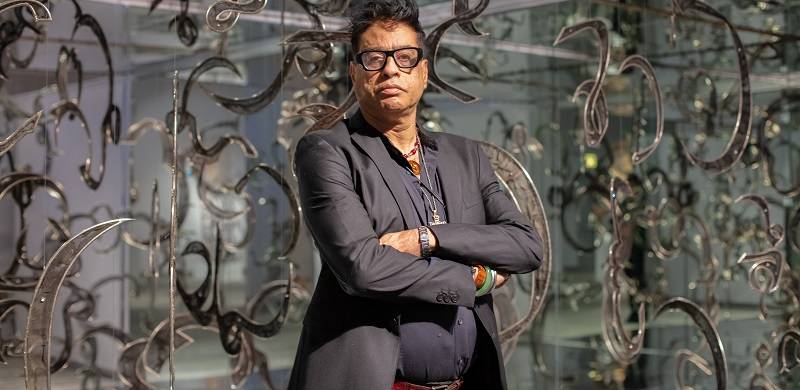
Amin Gulgee is a disciple to his work. His practice is a veneration of the artistic process, a communion with material and its specific agency. Amin’s work is an incarnation of the intrinsic spirituality of this process, that which is wholly organic to the artist. Incarnation is the entering into flesh, into life, into an aesthetic experience. Each work is itself an incarnation of the oneness, the non-separation between the artist, his existence, and the primarily metal material. This is communicated to us not by language, but rather the multidimensional experience of its form and interaction with space. This nondualistic approach not only applies to his objects and installations, but also appears in his deep engagement with performance.
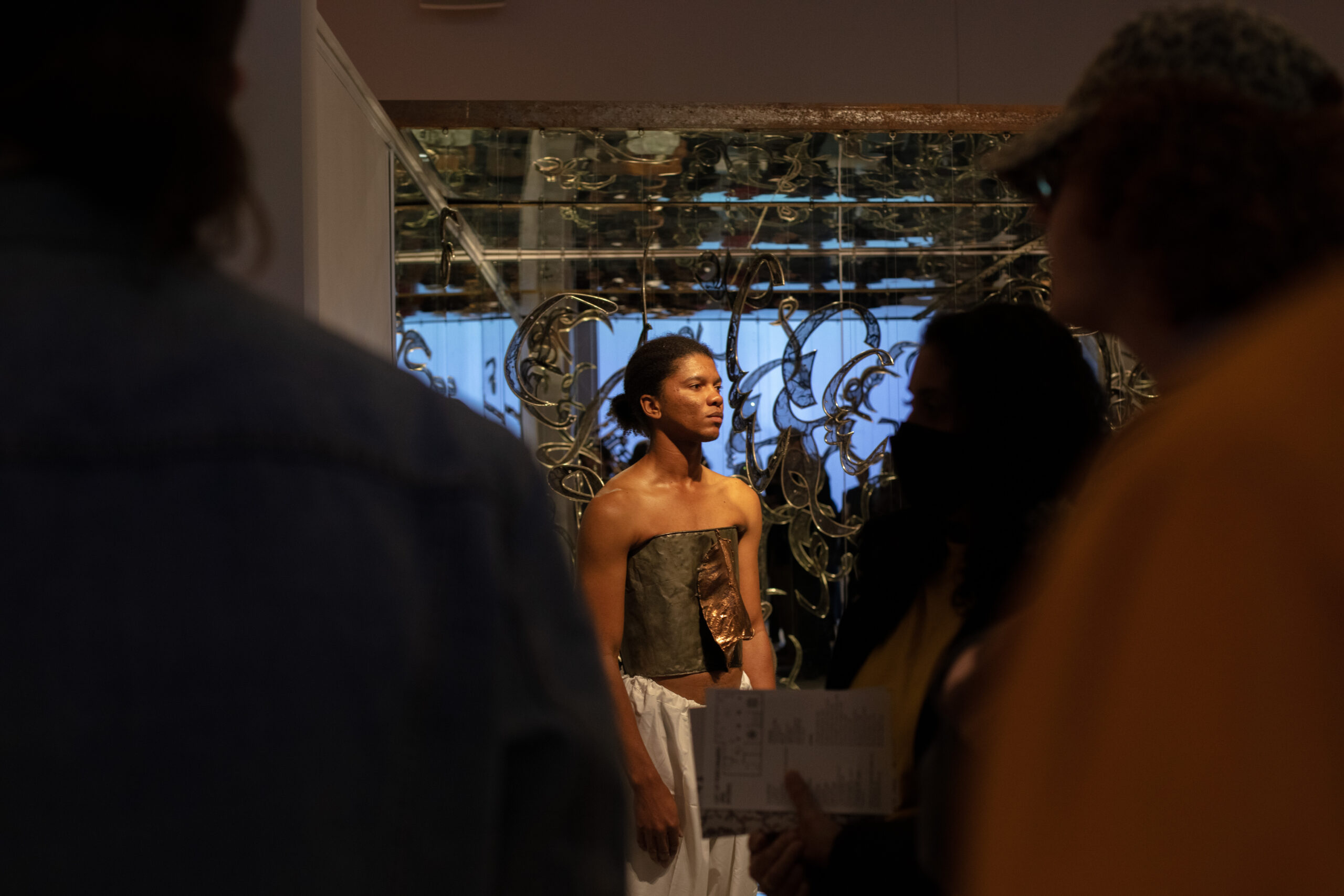 The Pentecostal narrative – speaking in tongues – becomes a prescient vehicle of understanding the manifestation of Amin Gulgee’s artistic practice. In the Acts of the Apostles (2:1-13), the disciples of Jesus, “were all with one accord in one place”, when: “there appeared unto them cloven tongues like as of fire, and it sat upon each of them. And they were all filled with the Holy Ghost, and began to speak with other tongues, as the Spirit gave them utterance.” (Acts 2:1-5) The initial coming of the Holy Spirit parallels the workshop for Amin; his space of cosmic inspiration, in which “tongues as of fire” appear to him in the heat and the intensity of working with copper and bronze – a profoundly spiritual experience. Yet when “the multitude came together […] out of every nation under heaven”, they “were confounded”, as they all “heard [the disciples] speak in [their] own native language.” (Acts 2:5-6) The multiplicity of Amin’s forms – as with the multiplicity of languages seemingly uttered by the disciples – is unified by the universal, ecstatic message of the Divine, creative inspiration, which dissolves linguistic and conceptual divisions in its experience. Even in the Pentecostal narrative the audience is left to interpret their experience: “And they were all amazed, and were in doubt, saying one to another, What meaneth this? Others mocking said, These [disciples] are full of new wine.” (Acts 2:12-13) Therein lies Amin’s invitation to his audience: it is for each individual to derive their own meaning from the experience, even if it echoes that of the more sceptical Pentecostal witnesses.
The Pentecostal narrative – speaking in tongues – becomes a prescient vehicle of understanding the manifestation of Amin Gulgee’s artistic practice. In the Acts of the Apostles (2:1-13), the disciples of Jesus, “were all with one accord in one place”, when: “there appeared unto them cloven tongues like as of fire, and it sat upon each of them. And they were all filled with the Holy Ghost, and began to speak with other tongues, as the Spirit gave them utterance.” (Acts 2:1-5) The initial coming of the Holy Spirit parallels the workshop for Amin; his space of cosmic inspiration, in which “tongues as of fire” appear to him in the heat and the intensity of working with copper and bronze – a profoundly spiritual experience. Yet when “the multitude came together […] out of every nation under heaven”, they “were confounded”, as they all “heard [the disciples] speak in [their] own native language.” (Acts 2:5-6) The multiplicity of Amin’s forms – as with the multiplicity of languages seemingly uttered by the disciples – is unified by the universal, ecstatic message of the Divine, creative inspiration, which dissolves linguistic and conceptual divisions in its experience. Even in the Pentecostal narrative the audience is left to interpret their experience: “And they were all amazed, and were in doubt, saying one to another, What meaneth this? Others mocking said, These [disciples] are full of new wine.” (Acts 2:12-13) Therein lies Amin’s invitation to his audience: it is for each individual to derive their own meaning from the experience, even if it echoes that of the more sceptical Pentecostal witnesses.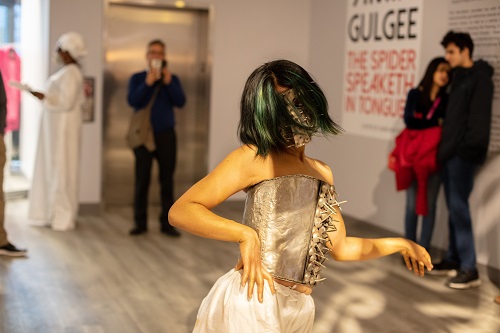
The Pentecost derives its name from being celebrated on the seventh Sunday from Easter Sunday, and originally, the seventh week after the first day of Passover – the fiftieth day. In Zero Gravity II, Amin has taken the fifth ayah of the Surah al-Alaq, which states that God ‘taught humanity what they knew not’ (Quran, 96:5), in the Naskh script, and deconstructed into seven constituent parts. It is a scriptural form – both in the sense of originating in scripture and being a specific Arabic script – transported into three-dimensions through its vertical re-arrangement, yet also rendered illegible by this.
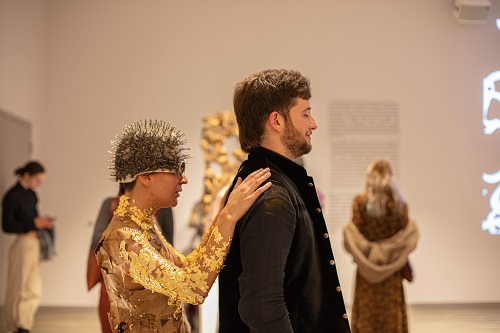 Algorithm VII utilises the same seven, scriptural components, projecting them to transition from black to white, and white to black again, algorithmically generating the characters to ensure a unique variation each time. This structuration also enters the sonic realm of experience. The seven characters are each assigned a note on the rubab – a lute-like instrument originating in Afghanistan – which then sounds in similarly unique rhythmic and tonal combinations.
Algorithm VII utilises the same seven, scriptural components, projecting them to transition from black to white, and white to black again, algorithmically generating the characters to ensure a unique variation each time. This structuration also enters the sonic realm of experience. The seven characters are each assigned a note on the rubab – a lute-like instrument originating in Afghanistan – which then sounds in similarly unique rhythmic and tonal combinations.
Beyond the shared scriptural basis, these pieces are interconnected by the emphasis placed on the interaction between form, structure and space. A crucial feature of Amin’s sculpture, in this context it is epitomised by the Perforated Scrolls, which enjoy a liminal position between Zero Gravity II and Algorithm VII. Their ostensible flatness as rectangular screens echo a page of scripture. Their inverse interrelationship in the punctuation of space mirrors the constant black-to-white transition of the projection, as well as the sonic punctuation correspondingly enacted by the rubab. The seven deconstructed, scriptural forms populate the Spice Tray and Liminal Letters installations, their re-arrangement once more operating on divergent dimensional planes. In their own way and within the same scriptural parameters, each manifests the fundamental interplay of light and shadow; form, structure and space, which lies at the core of Amin Gulgee’s artistic practice.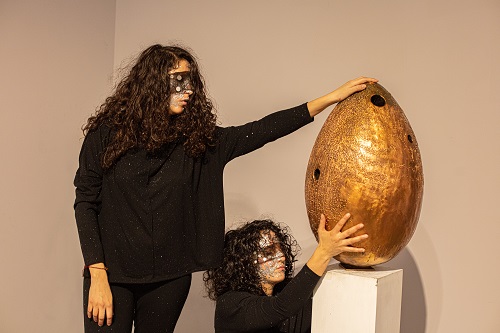
In the geometric form of Nonbinary Cube, this interrelationship between structure and space is even further elaborated. Within the cubic parameters, the interlocking structure is asymmetrical, presenting a divergent punctuation of space from every perspective.
Amin treats space as its own material. As with copper, it pertains to its own agency, and enters into a dance with the form. There is a unification of the sculptural and spatial, establishing quantum worlds in between the copper structure and the materiality of the empty space. Yet there is another interconnection. The form itself is scriptural, derived from the invocation ‘Alhamdulillah’ (‘Praise be to God’), in the Square Kufic script.
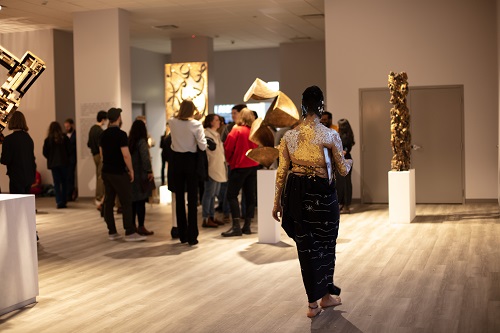 Geometric form has always been alluring to Amin Gulgee. His approach to geometricity invokes balance, something which is obviously crucial in constructing his free-standing metal structures. Four Quarter Chapatis and Three Folded Chapatis are interwoven with this geometricity. The chapatis are formed by concentric circles of interlaced copper. They are folded, much like one would with the titular South Asian flatbread to conserve their heat. Then they merge together, creating structures with a quadrilateral, cubic relationship to empty space, despite their original circular form. Both the circular and the quadrilateral, symbols of divine unity in Islamic geometric design, are encoded by the cosmic coupling of the maker and the material.
Geometric form has always been alluring to Amin Gulgee. His approach to geometricity invokes balance, something which is obviously crucial in constructing his free-standing metal structures. Four Quarter Chapatis and Three Folded Chapatis are interwoven with this geometricity. The chapatis are formed by concentric circles of interlaced copper. They are folded, much like one would with the titular South Asian flatbread to conserve their heat. Then they merge together, creating structures with a quadrilateral, cubic relationship to empty space, despite their original circular form. Both the circular and the quadrilateral, symbols of divine unity in Islamic geometric design, are encoded by the cosmic coupling of the maker and the material.
Amin’s sculptural practice has continuously incorporated Islamic and South Asian aesthetics as sources of inspiration, as seen in his Charbagh installation. This ancient ‘fourfold’ garden has its pre-Islamic origins in Persia, yet its plan became symbolic of the four gardens of Jannah (‘Paradise, garden’). In South Asia, they were a persistently resplendent feature of Mughal cultural production. These charbagh functioned as horticultural-architectonic embodiments of the inseparable interconnectedness of the human and natural, earthly and divine, the external and internal; creating quotidian spaces in which one could experience, contemplate and repose in this harmonious unification. Copper is itself a cosmically organic material. It hails from a process of nucleosynthesis in stars at least eight times the size of our sun. When these ‘massive stars’ explode into supernovae, the copper is propelled into space, and eventually future generations of stars. This intermingling between the cosmic, organic and geometric is thus enacted by the copper leaves emerging from mirror in a quadripartite plan; a Charbagh the audience is encouraged to enter into by Amin.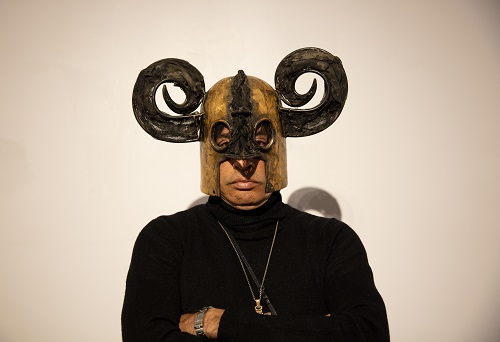
His Infinity Egg similarly emphasises the interconnectedness of human and natural, earthly and cosmic, internal and external. It is almost literal, in the sense that Amin’s artistic process of copulation with copper has given birth to such a form. Whilst they come from external sources of inspiration, his forms derive from that which comes from within. The ovoid form – like many of his interwoven threads of sculptural form – becomes, for the observer, prescient in its recurrence. It allows us entry into the profundity of the artistic process for Amin; a process that is inextricable, inseparable from his existence. This is not concealed by the artist. It is delighted in.
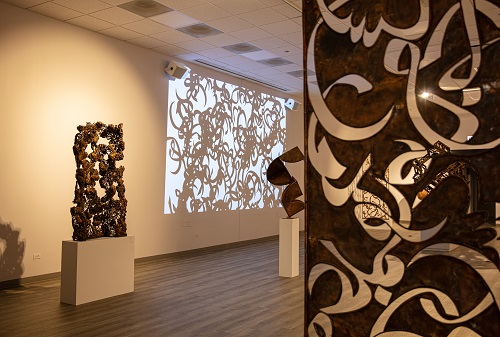 Hands are another organic form that has recurred throughout Amin Gulgee’s trajectory. They are his hands, in the same way they are his eggs, his ova – some part that comes from within. Yet each is unique, with its own gesture, a sense of its own being. In Ripping the Bird’s Nest, the maker’s hands are enmeshed in a web of copper. The hands seem to be attempting to free themselves from the moment in time in which they are entangled. They are simultaneously forming the copper web, and ripping it, attempting to extricate themselves, which implies both the creative and destructive tendencies imbued within the making process.
Hands are another organic form that has recurred throughout Amin Gulgee’s trajectory. They are his hands, in the same way they are his eggs, his ova – some part that comes from within. Yet each is unique, with its own gesture, a sense of its own being. In Ripping the Bird’s Nest, the maker’s hands are enmeshed in a web of copper. The hands seem to be attempting to free themselves from the moment in time in which they are entangled. They are simultaneously forming the copper web, and ripping it, attempting to extricate themselves, which implies both the creative and destructive tendencies imbued within the making process.
Amin embodies his profound interrelationship with his metal medium by using casts of his face as a formal constituent of the sculpture. The self, subject, and maker, is sublimated into the material, the object, the made. The most recent of these self-portraiture pieces is Loss of Face, which is proliferated with facial forms in bronze, melding them together to establish a singular entity from the multiplicity of selves. This is an introspective exploration of his inner self at a particular moment in time, one which the artist conducts at regular intervals. It is a highly therapeutic and meditative process, and returning to it is an existential necessity for Amin.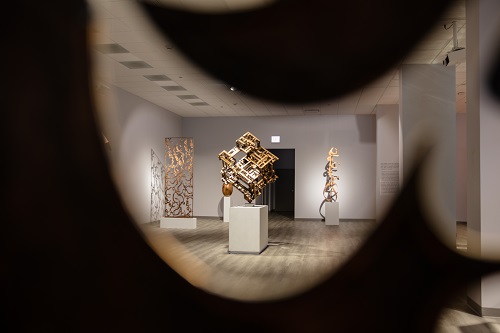
Amin Gulgee’s sculptural corpus is an interwoven web of formal threads; a copper web. In terms of the sculptural forms, Amin follows and reproduces strands that are the enmeshed, entangled emanations of his existence. This copper cobweb is his life, calling, habitat, and source of sustenance. The metallic, sculptural part of the wider artistic web is a sacred place of solitude for Amin, with the artist-as-arachnid at the introspective centre, continuously secreting strands of silk that elaborate and evolve its overall composition. Each of the threads are integrally interconnected in the web as a whole, following their own process of evolution, with their own threads, story and logic. This coalesces in Spider Raga VI, which once more derives its constituent parts from the same Quranic line underlying Zero Gravity II, Algorithm VII and his Perforated Scrolls. In Spider Raga VI, the scriptural assemblage takes on an arachnidian form. The titular addition of raga is significant. A raga, which has no true Western translation, is a system of South Asian classical music that provides a melodic framework for improvisation and elaboration according to the emotions and atmosphere that the highly-skilled performer can evoke. It uses a set of five or more notes from the fixed scale of seven notes, to construct a melody. Each work within the scriptural parameters is a raga, performed by Amin in the metal workshop. They all use a set of notes from a scriptural scale, yet each composition comprises a specific combination of these notes, which are used by Amin to create a form, texture and structure – with its own balance and atmosphere – that is unique to the sculpture.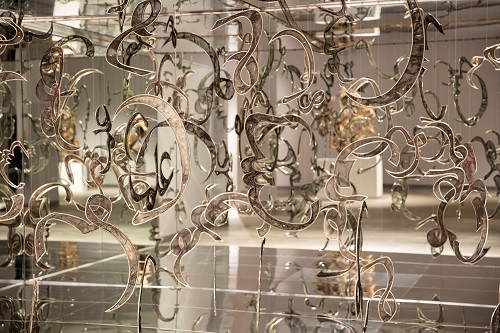
Amin’s copper web lies within the larger web of his artistic praxis, which is not limited to sculpture, but also encompasses performance and curation. For Amin Gulgee, there is only one holistic approach to art, aesthetic experience, and existence. The specific practice or context may change, but this underlying, nondualistic approach does not. For this reason, it was essential that The Spider Speaketh in Tongues included its own performative activation, “The Kiss of the Spider Woman”. This will be experiential and transient, with a duration of seventy-seven minutes, the audience will move through the space, witnessing simultaneous performances embedded in the installation.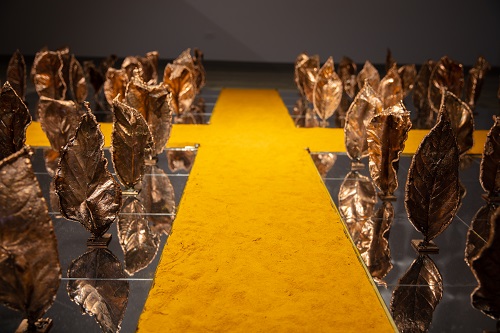
The performative in its multifarious forms – from the earliest stages of Amin’s trajectory – has manifested a mode of embodying objects; of activating the spirituality imbued within them, whilst ensuring corporeal communion with the copper forms. As his personal performative practice has evolved, it has metamorphosed into a consistent channel of ritualistic expression; a form of worship stemming from his veneration of the creative process – a vital embodiment of his artistic glossolalia. It allows for tangible dissolutions and explorations of gender and sexuality, themes which are imbued within Amin’s process and its products. Human agents activate the power imparted in the process of creating these sculptural objects. The agent enters a liminal realm between subject and object. It is a performance of the sculptural and an embodiment of objects; a process of becoming. Not only do the performers become one with the sculptural objects. They become one with the installation; they become one with Amin. There is no separation between Amin and those integrated within the artistic web as collaborators. It is an interconnection between the self and others that mirrors the non-separation of subject and object when either performing or forming a sculpture. The performers become a kinetic part of the installation, removing a further layer of separation between the sculptural forms and the perceiving agents, deepening their immersion into the holistic experience. Amin is joined by other disciples, “all with one accord in one place”, whereupon they begin to “speak with other tongues”. It is left for the audience to ask, “What meaneth this?”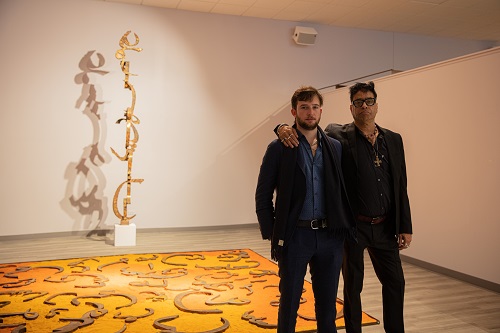
The Spider Speaketh in Tongues is the culmination of a five-year period of intensive collaboration between Amin and myself. This process began with the curatorial. In 2017, whilst he was the Chief Curator of the inaugural Karachi Biennale, Amin included me as a member of his curatorial team. The fact that Amin took a chance on me, an unknown entity of an undergraduate student with no practical experience, instinctively incorporating me as a valued member of his team, is characteristic of the approach that has rendered him one of Pakistan’s most dynamic artistic figures for the past three decades. It was a further manifestation of the fundamental emphasis Amin has placed on collaborating with younger generations, throughout his trajectory. From that point, and the intense labour of realising Pakistan’s first biennale on a shoe-string budget, to the present moment, our relationship has developed into a constant continuum of collaboration and dialogue. What began with the Karachi Biennale in 2017, has led continuously through 7 and 7.7 to The Trojan Donkey, Healing II, my Master’s thesis, The Q Rickshaw Project, and now, The Spider Speaketh in Tongues. In a much broader sense, Amin has provided me with a prism with which to understand creation, collaboration, aesthetic experience and the endeavour to evolve your own existence, especially in a fraught context such as Karachi.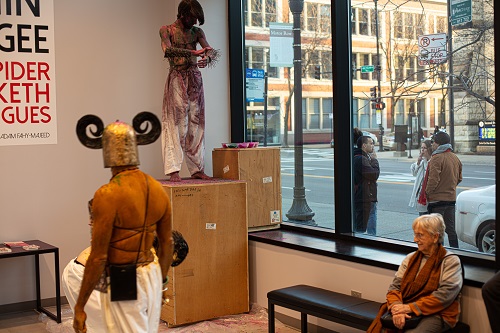
It was thus important to incorporate documentation of two recent curatorial projects that we collaborated on, Healing II and The Q Rickshaw Project, as an introduction to our collective work that can be viewed from South Michigan Avenue. The Q Rickshaw Project, which took place on the 30th of January 2022, comprising of nine performances, was conducted in a rickshaw of Amin’s creation, as it moved along a specific route in the heart of Karachi. The megalopolis, in which we are both based, is often an unknown quantity outside of our context, which people have difficulty imagining. This nomadic performance provided an opportunity for the artists in the rickshaw to engage with the city at large, inviting the visually curious public to interact. The documentation brings our Chicago audience into the context of a Sunday in Karachi; performatively, visually, and sonically.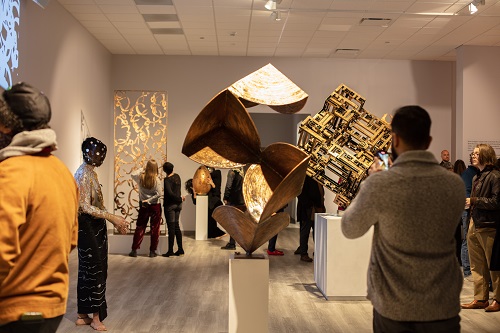
Healing II took place on the 1st of July, 2020, at the height of the first wave of COVID-19 in Pakistan. The ritual encounter, catalysed and embodied by Amin Gulgee, was a layered act of healing. It placed me in the unfamiliar position of performer, eliciting an inimitably embodied perspectival shift, whilst also attesting to the salutary effects of such a ritual. This demonstrates the way in which Amin involves and inspires individuals to express their protagonism in contexts of collaboration. You feel valued as a collaborator that is integral to the whole of the specific endeavour. Beyond this, it exemplifies how one project with Amin leads into another, and as a collaborator, one finds themselves consistently called upon to contribute to the experimental continuum. As with his sculptural forms and installations, one finds themselves entangled in the spider’s web.
 The Pentecostal narrative – speaking in tongues – becomes a prescient vehicle of understanding the manifestation of Amin Gulgee’s artistic practice. In the Acts of the Apostles (2:1-13), the disciples of Jesus, “were all with one accord in one place”, when: “there appeared unto them cloven tongues like as of fire, and it sat upon each of them. And they were all filled with the Holy Ghost, and began to speak with other tongues, as the Spirit gave them utterance.” (Acts 2:1-5) The initial coming of the Holy Spirit parallels the workshop for Amin; his space of cosmic inspiration, in which “tongues as of fire” appear to him in the heat and the intensity of working with copper and bronze – a profoundly spiritual experience. Yet when “the multitude came together […] out of every nation under heaven”, they “were confounded”, as they all “heard [the disciples] speak in [their] own native language.” (Acts 2:5-6) The multiplicity of Amin’s forms – as with the multiplicity of languages seemingly uttered by the disciples – is unified by the universal, ecstatic message of the Divine, creative inspiration, which dissolves linguistic and conceptual divisions in its experience. Even in the Pentecostal narrative the audience is left to interpret their experience: “And they were all amazed, and were in doubt, saying one to another, What meaneth this? Others mocking said, These [disciples] are full of new wine.” (Acts 2:12-13) Therein lies Amin’s invitation to his audience: it is for each individual to derive their own meaning from the experience, even if it echoes that of the more sceptical Pentecostal witnesses.
The Pentecostal narrative – speaking in tongues – becomes a prescient vehicle of understanding the manifestation of Amin Gulgee’s artistic practice. In the Acts of the Apostles (2:1-13), the disciples of Jesus, “were all with one accord in one place”, when: “there appeared unto them cloven tongues like as of fire, and it sat upon each of them. And they were all filled with the Holy Ghost, and began to speak with other tongues, as the Spirit gave them utterance.” (Acts 2:1-5) The initial coming of the Holy Spirit parallels the workshop for Amin; his space of cosmic inspiration, in which “tongues as of fire” appear to him in the heat and the intensity of working with copper and bronze – a profoundly spiritual experience. Yet when “the multitude came together […] out of every nation under heaven”, they “were confounded”, as they all “heard [the disciples] speak in [their] own native language.” (Acts 2:5-6) The multiplicity of Amin’s forms – as with the multiplicity of languages seemingly uttered by the disciples – is unified by the universal, ecstatic message of the Divine, creative inspiration, which dissolves linguistic and conceptual divisions in its experience. Even in the Pentecostal narrative the audience is left to interpret their experience: “And they were all amazed, and were in doubt, saying one to another, What meaneth this? Others mocking said, These [disciples] are full of new wine.” (Acts 2:12-13) Therein lies Amin’s invitation to his audience: it is for each individual to derive their own meaning from the experience, even if it echoes that of the more sceptical Pentecostal witnesses.
The Pentecost derives its name from being celebrated on the seventh Sunday from Easter Sunday, and originally, the seventh week after the first day of Passover – the fiftieth day. In Zero Gravity II, Amin has taken the fifth ayah of the Surah al-Alaq, which states that God ‘taught humanity what they knew not’ (Quran, 96:5), in the Naskh script, and deconstructed into seven constituent parts. It is a scriptural form – both in the sense of originating in scripture and being a specific Arabic script – transported into three-dimensions through its vertical re-arrangement, yet also rendered illegible by this.
 Algorithm VII utilises the same seven, scriptural components, projecting them to transition from black to white, and white to black again, algorithmically generating the characters to ensure a unique variation each time. This structuration also enters the sonic realm of experience. The seven characters are each assigned a note on the rubab – a lute-like instrument originating in Afghanistan – which then sounds in similarly unique rhythmic and tonal combinations.
Algorithm VII utilises the same seven, scriptural components, projecting them to transition from black to white, and white to black again, algorithmically generating the characters to ensure a unique variation each time. This structuration also enters the sonic realm of experience. The seven characters are each assigned a note on the rubab – a lute-like instrument originating in Afghanistan – which then sounds in similarly unique rhythmic and tonal combinations.Beyond the shared scriptural basis, these pieces are interconnected by the emphasis placed on the interaction between form, structure and space. A crucial feature of Amin’s sculpture, in this context it is epitomised by the Perforated Scrolls, which enjoy a liminal position between Zero Gravity II and Algorithm VII. Their ostensible flatness as rectangular screens echo a page of scripture. Their inverse interrelationship in the punctuation of space mirrors the constant black-to-white transition of the projection, as well as the sonic punctuation correspondingly enacted by the rubab. The seven deconstructed, scriptural forms populate the Spice Tray and Liminal Letters installations, their re-arrangement once more operating on divergent dimensional planes. In their own way and within the same scriptural parameters, each manifests the fundamental interplay of light and shadow; form, structure and space, which lies at the core of Amin Gulgee’s artistic practice.

In the geometric form of Nonbinary Cube, this interrelationship between structure and space is even further elaborated. Within the cubic parameters, the interlocking structure is asymmetrical, presenting a divergent punctuation of space from every perspective.
Amin treats space as its own material. As with copper, it pertains to its own agency, and enters into a dance with the form. There is a unification of the sculptural and spatial, establishing quantum worlds in between the copper structure and the materiality of the empty space. Yet there is another interconnection. The form itself is scriptural, derived from the invocation ‘Alhamdulillah’ (‘Praise be to God’), in the Square Kufic script.
 Geometric form has always been alluring to Amin Gulgee. His approach to geometricity invokes balance, something which is obviously crucial in constructing his free-standing metal structures. Four Quarter Chapatis and Three Folded Chapatis are interwoven with this geometricity. The chapatis are formed by concentric circles of interlaced copper. They are folded, much like one would with the titular South Asian flatbread to conserve their heat. Then they merge together, creating structures with a quadrilateral, cubic relationship to empty space, despite their original circular form. Both the circular and the quadrilateral, symbols of divine unity in Islamic geometric design, are encoded by the cosmic coupling of the maker and the material.
Geometric form has always been alluring to Amin Gulgee. His approach to geometricity invokes balance, something which is obviously crucial in constructing his free-standing metal structures. Four Quarter Chapatis and Three Folded Chapatis are interwoven with this geometricity. The chapatis are formed by concentric circles of interlaced copper. They are folded, much like one would with the titular South Asian flatbread to conserve their heat. Then they merge together, creating structures with a quadrilateral, cubic relationship to empty space, despite their original circular form. Both the circular and the quadrilateral, symbols of divine unity in Islamic geometric design, are encoded by the cosmic coupling of the maker and the material.Amin’s sculptural practice has continuously incorporated Islamic and South Asian aesthetics as sources of inspiration, as seen in his Charbagh installation. This ancient ‘fourfold’ garden has its pre-Islamic origins in Persia, yet its plan became symbolic of the four gardens of Jannah (‘Paradise, garden’). In South Asia, they were a persistently resplendent feature of Mughal cultural production. These charbagh functioned as horticultural-architectonic embodiments of the inseparable interconnectedness of the human and natural, earthly and divine, the external and internal; creating quotidian spaces in which one could experience, contemplate and repose in this harmonious unification. Copper is itself a cosmically organic material. It hails from a process of nucleosynthesis in stars at least eight times the size of our sun. When these ‘massive stars’ explode into supernovae, the copper is propelled into space, and eventually future generations of stars. This intermingling between the cosmic, organic and geometric is thus enacted by the copper leaves emerging from mirror in a quadripartite plan; a Charbagh the audience is encouraged to enter into by Amin.

His Infinity Egg similarly emphasises the interconnectedness of human and natural, earthly and cosmic, internal and external. It is almost literal, in the sense that Amin’s artistic process of copulation with copper has given birth to such a form. Whilst they come from external sources of inspiration, his forms derive from that which comes from within. The ovoid form – like many of his interwoven threads of sculptural form – becomes, for the observer, prescient in its recurrence. It allows us entry into the profundity of the artistic process for Amin; a process that is inextricable, inseparable from his existence. This is not concealed by the artist. It is delighted in.
 Hands are another organic form that has recurred throughout Amin Gulgee’s trajectory. They are his hands, in the same way they are his eggs, his ova – some part that comes from within. Yet each is unique, with its own gesture, a sense of its own being. In Ripping the Bird’s Nest, the maker’s hands are enmeshed in a web of copper. The hands seem to be attempting to free themselves from the moment in time in which they are entangled. They are simultaneously forming the copper web, and ripping it, attempting to extricate themselves, which implies both the creative and destructive tendencies imbued within the making process.
Hands are another organic form that has recurred throughout Amin Gulgee’s trajectory. They are his hands, in the same way they are his eggs, his ova – some part that comes from within. Yet each is unique, with its own gesture, a sense of its own being. In Ripping the Bird’s Nest, the maker’s hands are enmeshed in a web of copper. The hands seem to be attempting to free themselves from the moment in time in which they are entangled. They are simultaneously forming the copper web, and ripping it, attempting to extricate themselves, which implies both the creative and destructive tendencies imbued within the making process.Amin embodies his profound interrelationship with his metal medium by using casts of his face as a formal constituent of the sculpture. The self, subject, and maker, is sublimated into the material, the object, the made. The most recent of these self-portraiture pieces is Loss of Face, which is proliferated with facial forms in bronze, melding them together to establish a singular entity from the multiplicity of selves. This is an introspective exploration of his inner self at a particular moment in time, one which the artist conducts at regular intervals. It is a highly therapeutic and meditative process, and returning to it is an existential necessity for Amin.

Amin Gulgee’s sculptural corpus is an interwoven web of formal threads; a copper web. In terms of the sculptural forms, Amin follows and reproduces strands that are the enmeshed, entangled emanations of his existence. This copper cobweb is his life, calling, habitat, and source of sustenance. The metallic, sculptural part of the wider artistic web is a sacred place of solitude for Amin, with the artist-as-arachnid at the introspective centre, continuously secreting strands of silk that elaborate and evolve its overall composition. Each of the threads are integrally interconnected in the web as a whole, following their own process of evolution, with their own threads, story and logic. This coalesces in Spider Raga VI, which once more derives its constituent parts from the same Quranic line underlying Zero Gravity II, Algorithm VII and his Perforated Scrolls. In Spider Raga VI, the scriptural assemblage takes on an arachnidian form. The titular addition of raga is significant. A raga, which has no true Western translation, is a system of South Asian classical music that provides a melodic framework for improvisation and elaboration according to the emotions and atmosphere that the highly-skilled performer can evoke. It uses a set of five or more notes from the fixed scale of seven notes, to construct a melody. Each work within the scriptural parameters is a raga, performed by Amin in the metal workshop. They all use a set of notes from a scriptural scale, yet each composition comprises a specific combination of these notes, which are used by Amin to create a form, texture and structure – with its own balance and atmosphere – that is unique to the sculpture.

Amin’s copper web lies within the larger web of his artistic praxis, which is not limited to sculpture, but also encompasses performance and curation. For Amin Gulgee, there is only one holistic approach to art, aesthetic experience, and existence. The specific practice or context may change, but this underlying, nondualistic approach does not. For this reason, it was essential that The Spider Speaketh in Tongues included its own performative activation, “The Kiss of the Spider Woman”. This will be experiential and transient, with a duration of seventy-seven minutes, the audience will move through the space, witnessing simultaneous performances embedded in the installation.

The performative in its multifarious forms – from the earliest stages of Amin’s trajectory – has manifested a mode of embodying objects; of activating the spirituality imbued within them, whilst ensuring corporeal communion with the copper forms. As his personal performative practice has evolved, it has metamorphosed into a consistent channel of ritualistic expression; a form of worship stemming from his veneration of the creative process – a vital embodiment of his artistic glossolalia. It allows for tangible dissolutions and explorations of gender and sexuality, themes which are imbued within Amin’s process and its products. Human agents activate the power imparted in the process of creating these sculptural objects. The agent enters a liminal realm between subject and object. It is a performance of the sculptural and an embodiment of objects; a process of becoming. Not only do the performers become one with the sculptural objects. They become one with the installation; they become one with Amin. There is no separation between Amin and those integrated within the artistic web as collaborators. It is an interconnection between the self and others that mirrors the non-separation of subject and object when either performing or forming a sculpture. The performers become a kinetic part of the installation, removing a further layer of separation between the sculptural forms and the perceiving agents, deepening their immersion into the holistic experience. Amin is joined by other disciples, “all with one accord in one place”, whereupon they begin to “speak with other tongues”. It is left for the audience to ask, “What meaneth this?”

The Spider Speaketh in Tongues is the culmination of a five-year period of intensive collaboration between Amin and myself. This process began with the curatorial. In 2017, whilst he was the Chief Curator of the inaugural Karachi Biennale, Amin included me as a member of his curatorial team. The fact that Amin took a chance on me, an unknown entity of an undergraduate student with no practical experience, instinctively incorporating me as a valued member of his team, is characteristic of the approach that has rendered him one of Pakistan’s most dynamic artistic figures for the past three decades. It was a further manifestation of the fundamental emphasis Amin has placed on collaborating with younger generations, throughout his trajectory. From that point, and the intense labour of realising Pakistan’s first biennale on a shoe-string budget, to the present moment, our relationship has developed into a constant continuum of collaboration and dialogue. What began with the Karachi Biennale in 2017, has led continuously through 7 and 7.7 to The Trojan Donkey, Healing II, my Master’s thesis, The Q Rickshaw Project, and now, The Spider Speaketh in Tongues. In a much broader sense, Amin has provided me with a prism with which to understand creation, collaboration, aesthetic experience and the endeavour to evolve your own existence, especially in a fraught context such as Karachi.

It was thus important to incorporate documentation of two recent curatorial projects that we collaborated on, Healing II and The Q Rickshaw Project, as an introduction to our collective work that can be viewed from South Michigan Avenue. The Q Rickshaw Project, which took place on the 30th of January 2022, comprising of nine performances, was conducted in a rickshaw of Amin’s creation, as it moved along a specific route in the heart of Karachi. The megalopolis, in which we are both based, is often an unknown quantity outside of our context, which people have difficulty imagining. This nomadic performance provided an opportunity for the artists in the rickshaw to engage with the city at large, inviting the visually curious public to interact. The documentation brings our Chicago audience into the context of a Sunday in Karachi; performatively, visually, and sonically.

Healing II took place on the 1st of July, 2020, at the height of the first wave of COVID-19 in Pakistan. The ritual encounter, catalysed and embodied by Amin Gulgee, was a layered act of healing. It placed me in the unfamiliar position of performer, eliciting an inimitably embodied perspectival shift, whilst also attesting to the salutary effects of such a ritual. This demonstrates the way in which Amin involves and inspires individuals to express their protagonism in contexts of collaboration. You feel valued as a collaborator that is integral to the whole of the specific endeavour. Beyond this, it exemplifies how one project with Amin leads into another, and as a collaborator, one finds themselves consistently called upon to contribute to the experimental continuum. As with his sculptural forms and installations, one finds themselves entangled in the spider’s web.

